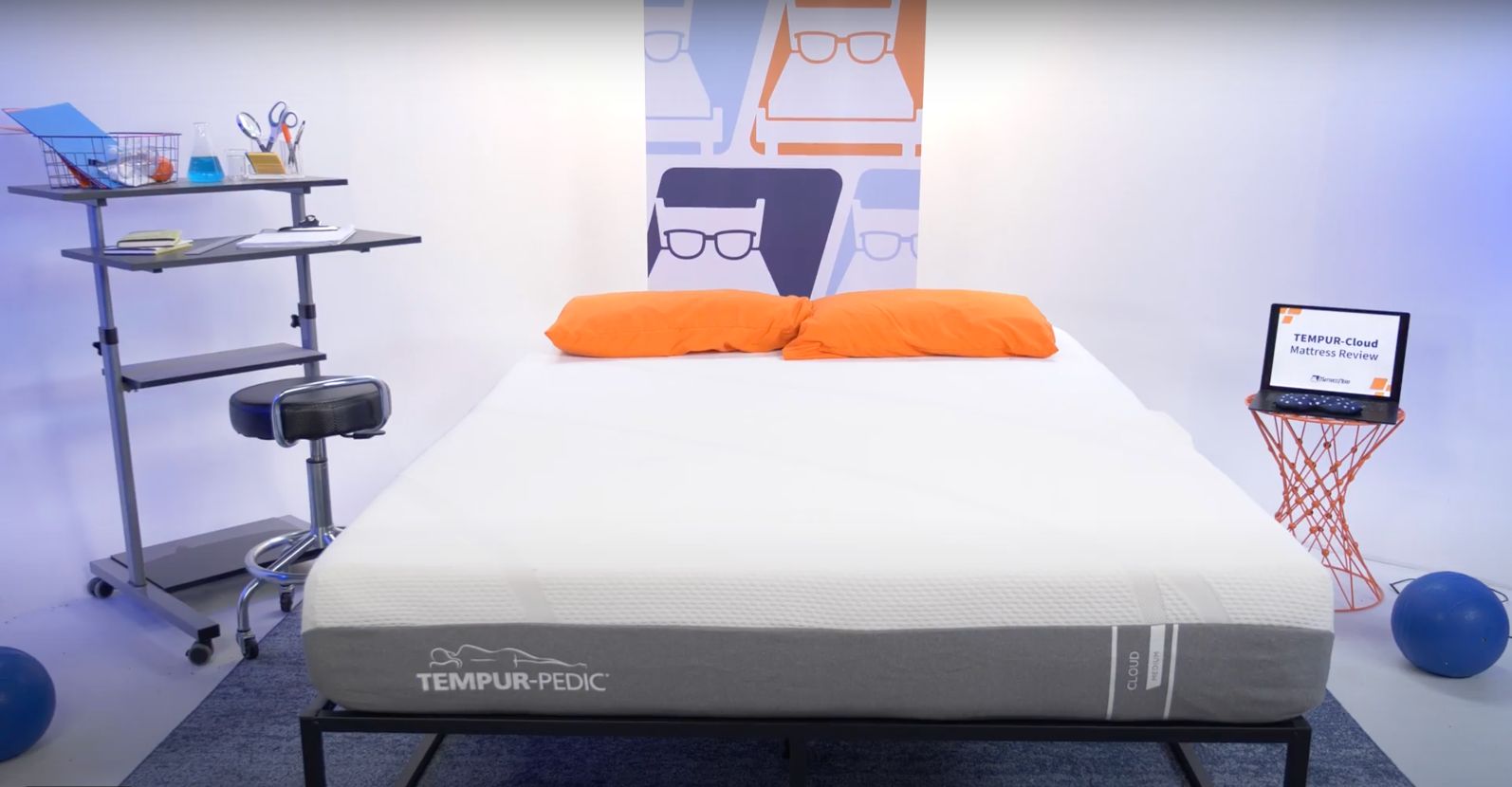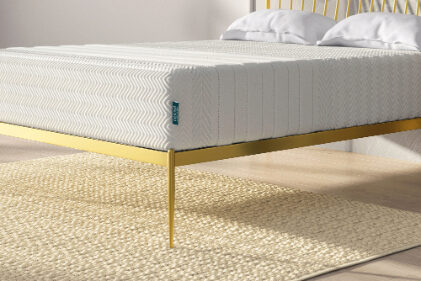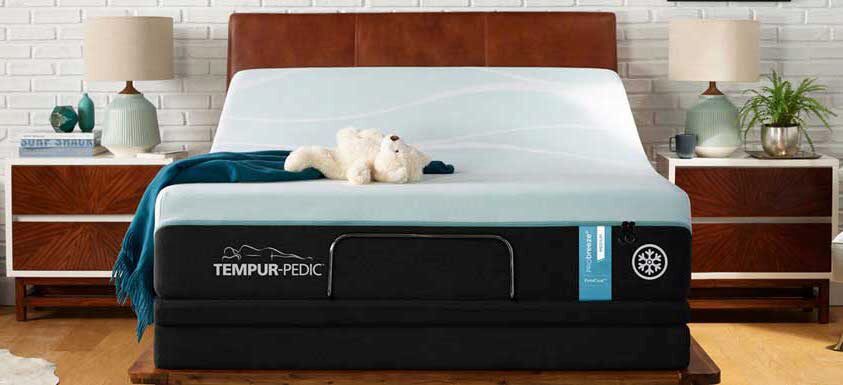Product
Firmness
Score

Product
Firmness
Score

Disclosure: By clicking on the product links in this article, Mattress Nerd may receive a commission fee at no cost to you, the reader. Read full disclosure statement.
If you’d like to shop for highly-regarded mattresses, the Leesa and Tempurpedic are both great options for you. To help you choose which among the two would best fit your needs, read through this review to learn more about its benefits, sizing, prices, mattress construction, and more. You may also check out what others say about them through our testing methodology.


The Leesa and Tempurpedic mattresses both have their distinct features and qualities, read below to know which one best suits your liking.
| Leesa is best for… | Tempurpedic is best for… |
| Those with back pain | Side sleepers |
| Combination sleepers | Couples |
| Sleepers who sleep in all positions | Back sleepers |


We’ve compared the firmness, feel, and comfort between Leesa and Tempurpedic to help you decide which is better for your needs!
The Leesa mattress’ firmness level is medium-soft and scores 5.5/10, while the Tempurpedic firmness level ranges between medium-firm and scores 6.5/10. The Leesa mattress is great for people who are lightweight or average-weight and need pressure relief, while the Tempurpedic mattress is better suited to heavier individuals who want extra support in their sleep space.
The Leesa mattress has a bouncy-soft feel that keeps you cool to the touch, no matter your position. It’s best for people who prefer a more bouncy feel to their mattress but still want to be supported (and not just sink into it) as they sleep. Meanwhile, the Tempurpedic mattress is made to hug your body, keeping you lifted on top of the mattress and supported through the night. It’s great for people who have back pain or feel like they’re sinking into their mattress when they sleep.
The Tempurpedic mattress is soft and responsive but not so soft that you’ll sink in too far. It’s firm enough to give you great support throughout the night. If you sleep on your back or stomach, the Leesa mattress will feel like an ideal combination of softness and firmness—you won’t feel stuck in one position. Finally, if you’re a combination sleeper (both stomach and back), then the Tempurpedic and Leesa mattresses are ideal.
Leesa Performance By Body Type & Sleeping Position:
| Body Type: | BACK SLEEPERS | STOMACH SLEEPERS | SIDE SLEEPERS |
| Lightweight (< 130 lbs): | 5 | 4 | 4 |
| Average-weight (130–230 lbs): | 5 | 3 | 3 |
| Heavyweight (> 230 lbs): | 2 | 1 | 2 |
Tempurpedic Performance By Body Type & Sleeping Position:
| Body Type: | BACK SLEEPERS | STOMACH SLEEPERS | SIDE SLEEPERS |
| Lightweight (< 130 lbs): | 5 | 3 | 4 |
| Average-weight (130–230 lbs): | 5 | 2 | 4 |
| Heavyweight (> 230 lbs): | 4 | 2 | 4 |
If you’re an average-weight individual side sleeper or back sleeper, the Leesa and Tempurpedic mattresses are both great options for you. Stomach sleepers may also consider both mattresses because they support where it’s needed most—the shoulders and hips in these positions. The Tempurpedic mattress is designed to support any sleeping position by carefully balancing pressure relief with support.
For heavyweight sleepers, the Leesa mattress might not be the best choice for you. The mattress is designed to help all types of sleepers, but it can be a bit too soft for those who weigh more than 230 lbs. This means it doesn’t provide enough support for side and stomach sleepers, who will sink into the mattress too much and may even feel like falling out of bed. Meanwhile, Tempurpedic works well for back sleepers but not so much for stomach and side sleepers. The memory foam adjusts to your body as you move around throughout the night, which helps reduce pressure points on your hips or shoulders (which can cause pain).
If you’re a lightweight sleeper, then Leesa and Tempurpedic mattresses are for you. These mattresses are designed to be lighter than other mattresses, so they won’t weigh you down and make it hard to move around in the middle of the night. Their materials also make them more breathable for side, back, and stomach sleepers which means they won’t trap heat like other memory foam mattresses.


Both Leesa and Tempurpedic mattresses have different constructions but also many similarities. Let’s take a look at what makes them different and how they compare to each other.
| Leesa Mattress Materials | Tempurpedic Mattress Materials |
| Twill Fabric Cover | Cool-to-Touch Cover |
| Proprietary LSA200 Foam | Tempur-es Foam |
| Memory Foam | Original Tempur Support Foam |
| Support Foam | Support Foam |
| 10” | 11” |
The Leesa mattress comes with its recognizable gray twill mattress cover, which is woven for added ventilation. The Tempurpedic mattress cover has an antimicrobial material, waving goodbye to allergens, and a cool-to-touch cover for added comfort.
Designed for breathability, the LSA200 comfort foam of the Leesa mattress reduces heat retention while Tempurpedic’s Tempur-es memory foam offers the slow sink and “in the mattress” feeling that’s generally associated with memory foam.
The Leesa mattress is made with a high-density foam support layer. This layer is designed to be firm, emphasizing stability and durability. Meanwhile, the Tempur Support Layer of the Tempurpedic mattress is designed to contour your body’s shape, providing the comfort you need for a restful night’s sleep.
| Size | Leesa Prices | Tempurpedic Prices |
| Twin | $849.00 | $1699.00 |
| Twin XL | $899.00 | $1699.00 |
| Full | $1099.00 | $1899.00 |
| Queen | $1299.00 | $1999.00 |
| King | $1599.00 | $2399.00 |
| California King | $1599.00 | $2399.00 |
For exclusive discounts on both beds see our Leesa mattress coupons and Tempurpedic mattress coupons.
For each section, describe how the two mattresses compare. Use the performance scores and commentary from the individual mattress reviews.
While Leesa and Tempurpedic incorporate cooling features, we can confidently say that neither has a cool temperature profile. Both have breathable mattress covers, and Tempur-Pedic formulates their fabric to be cool on contact.
Both mattresses reduce motion transfer. The predominance of memory foam in the Tempurpedic mattress means it absorbs motion better, whereas the Leesa does just an average job.
Neither Leesa nor Tempurpedic offers extra firm foam or coils that reinforce the sides of the bed. There is more sinkage along the edges of Leesa, but if edge support is a factor you highly value, the hybrid version of the Tempurpedic mattress is ideal for you.
Both mattresses offer pressure relief, particularly for lightweight and average-weight individuals. We did notice a little extra pressure around the shoulders of heavyweight side sleepers on the Leesa, so we favor the Tempurpedic for that body type and sleeping position.
The Leesa and Tempurpedic mattresses provide pain relief for pressure points and improve spinal alignment. Both mattresses offer a combination of firmness and softness that supports your body in all the right places.
Leesa and Tempur-Pedic protect these mattresses with a 10-year warranty so that you can count on a functional mattress from either brand for at least a decade.
Leesa mattresses are made-to-order and shipped free around the U.S. with a guaranteed 10-year warranty. The company also offers a $150 service fee for old mattress removal and a 100-night sleep trial period. If unsatisfied with the product, you can request a free return and full refund, while defective mattresses are eligible for a free replacement.
All Tempurpedic mattress models come with free white glove delivery and old mattress removal. The company provides you with a 90-night trial period after shipping the product, and it also comes with free returns (minus a potential $175 return shipping fee). Like the Leesa mattress, Tempurpedic guarantees a 10-year warranty and free replacement for defective mattresses.





We love both of these mattresses. If you’re looking for a balanced feel that’s contouring, but not smothering, stick with the Leesa. It’s also a better choice for online mattress industry newcomers who want a reliably comfy foam bed that suits a broad range of sleepers.
The TEMPUR-Adapt is our choice for side sleepers who want the plush “hug” of memory foam. It’s also a dependable choice for shoppers looking to dip their toes in luxury mattress company offerings without totally breaking the bank. Plus, it’s available as a hybrid mattress for those who want a little more springiness.
The Leesa is a popular bed-in-a-box mattress that pairs memory foam with an exclusive comfort foam called LSA200. It is responsive and cushioning without compromising on whole-body support. On the other hand, the Tempurpedic mattress is a classic model made with memory foam and a supportive foam base.
The best way to decide which one will work best for you is to sit on both in-store, then ask yourself which one feels more comfortable. If you find yourself leaning toward one or the other, test them out and utilize their trial periods before making a decision!
Like any other mattresses, Leesa and Tempurpedic should be vacuumed every few months to eliminate dust mites (which can cause allergies) and other debris that builds up over time on top of your mattress’s fabric cover. If possible, wash your mattress protector regularly in warm water.